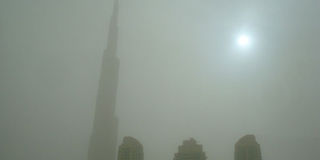Why the Earth doesn’t wobble when it rotates

PHOTO | FILE The Burj Khalifa (left) during a sandstorm. Even if the Earth was not as massive as it is, man-made structures would still not have much effect because they are scattered randomly across the surface of the planet.
With all the construction going on, Michael Mwendwa wonders why the mass of the earth doesn’t get imbalanced. Perhaps Michael is worried that if there was too much weight on one side, the planet’s rotation might become wobbly (the way a car with unbalanced wheels wobbles violently)!
It’s a valid concern but one that we shouldn’t worry too much about. The reason is that the Earth is simply too massive for any human construction to have significant effect on its motion. Let’s first look at what kind of mass displacement is involved.
Contrary to general expectation, the largest man-made structures are not buildings or walls. So you can strike off things like the Egyptian pyramids, the Chinese Great Wall and even the Burj Khalifa Tower in Dubai from that list.
The largest man-made structures are holes in the ground – mines and dams. One of them is the Kimberly diamond mine in South Africa. It is about 470m in diameter and 800m deep.
From the 1840s to 1910s, 23 million tonnes of earth was excavated from the Kimberly mine in search of diamonds. They extracted only 2.7 tonnes of diamonds! Now you know why this gem is so expensive.
The Mirny diamond mine in Russia is another serious contender measuring 1.25km across and 500m deep. However, at 4km wide and 970m depth, the Bingham Canyon mine in the USA is clearly the largest man-made open pit in the world.
But in terms of mass displacement, none of these mines can compete with the Three Gorges Dam in China. Completed in 2008, it holds about 40 million cubic metres of water with a surface area of over 1,000 square kilometres (2km wide at the front wall and 660km long).
To put those figures into perspective, compare it with our Masinga dam: 1.56 million cubic metres of water over 120 square kilometres (also 2km wide but only 45km long).
Now the 40 million cubic metres of water at the Three Gorges were not there before the dam was built. They are equivalent to 40 million tonnes in mass. How does that compare with our planet? Well the mass of the Earth is about 6,000,000,000,000,000,000,000 tonnes. That is, 6 followed by 21 zeroes!
In comparison, the number 40 million has only seven zeros. Thus, the proportion of the planet that has been held up at the dam is 1 in 150,000,000,000,000 (150 trillion)! That’s a very small fraction, therefore it doesn’t have any significant effect on the mass of the Earth.
But even if the Earth was not as massive as it is, these man-made structures would still not have much effect because they are scattered randomly across the surface of the planet. For example, before the Three Gorges dam was built, the previous record holder was the Itaipu in South America – at the border between Brazil and Paraguay.
Finally, let nobody ever cheat you: none of these structures can be seen from the moon. Indeed, no man-made feature is visible from there – not even the Great Wall of China!




